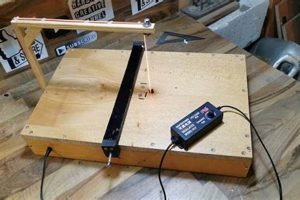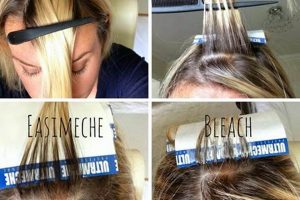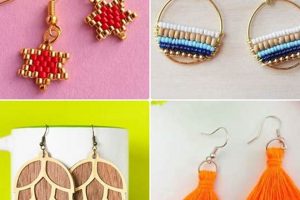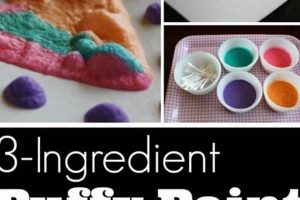Handcrafted pliable spheres designed to alleviate tension are gaining popularity. These items, often constructed from readily available household materials such as balloons, flour, or rice, offer a tactile outlet for stress and anxiety. For example, a balloon filled with cornstarch and sealed provides a malleable object for squeezing, offering a distraction from stressful thoughts.
The advantages of creating personalized stress relief tools are multifaceted. Beyond providing a physical mechanism for releasing tension, the construction process itself can be a calming activity. Furthermore, the ability to customize the materials and textures allows for a tailored sensory experience. The historical context of using physical objects for stress reduction dates back centuries, with more contemporary adaptations evolving from therapeutic practices aimed at sensory stimulation and emotional regulation.
The following sections will detail specific construction methods, material considerations, and potential variations for these personalized stress-reducing aids, ensuring a comprehensive understanding of their creation and application.
Crafting Durable and Effective Stress Relief Spheres
The creation of effective and long-lasting tension-relieving devices requires careful planning and execution. The following provides essential guidelines for maximizing the utility and longevity of these therapeutic tools.
Tip 1: Material Selection is Critical: Opt for high-quality, thick-walled balloons or alternative casings to minimize the risk of rupture. Thin balloons are prone to tearing, rendering the creation unusable and potentially messy.
Tip 2: Filling Consistency Matters: Finely ground materials, such as flour or cornstarch, generally provide a more uniform and pliable texture compared to coarser substances like rice or beans. Ensure complete dryness of filling materials to prevent mold growth.
Tip 3: Knot Security is Paramount: Securely tie the balloon closure to prevent leakage. Multiple knots or the use of rubber bands can provide additional reinforcement. Consider using a sealant, such as glue, for increased security.
Tip 4: Layering for Enhanced Durability: Encasing the primary filling within multiple layers of balloons significantly increases resistance to bursting. Each additional layer provides a buffer against the stresses of repeated use.
Tip 5: Regular Maintenance is Essential: Inspect the finished product regularly for signs of wear or damage. Promptly replace or repair any compromised creations to maintain hygiene and prevent premature failure.
Tip 6: Consider Ergonomic Design: Tailor the size and shape to comfortably fit the hand. An overly large creation may be difficult to manipulate, while an undersized one may not provide adequate tactile stimulation.
Tip 7: Explore Texture Variations: Experiment with adding small quantities of materials like sand or seeds to create varied tactile sensations. Ensure these additions are non-abrasive and do not compromise the casing’s integrity.
By adhering to these guidelines, individuals can create more effective, durable, and satisfying stress-relieving tools. The careful selection of materials, secure construction, and regular maintenance will ensure long-term usability and maximal therapeutic benefit.
The subsequent section will explore advanced customization techniques, including scent integration and aesthetic enhancements, to further personalize these beneficial creations.
1. Tactile Sensory Input
Tactile sensory input serves as a cornerstone in the efficacy of stress-relieving spheres. The relationship between the sphere and the individual hinges on the haptic experience, where pressure, texture, and weight interact to elicit a calming or diverting effect. The physical act of squeezing, manipulating, or even simply holding these items provides a tangible outlet for pent-up tension. For instance, a sphere filled with gel beads offers a yielding, cool sensation under pressure, directly contrasting with the tautness of strained muscles. The choice of filling materials, therefore, dictates the type and intensity of sensory feedback received, creating a direct cause-and-effect relationship between material selection and therapeutic outcome. The importance of tactile sensory input lies in its ability to shift focus from cognitive stressors to a physical sensation, momentarily interrupting the cycle of anxiety or tension.
The practical application of this understanding extends to the tailored design of these tools. Recognizing that individual sensory preferences vary widely informs the customization process. Some may prefer the smooth, consistent pressure of a flour-filled sphere, while others derive greater benefit from the irregular, granular texture of rice. By experimenting with different fillings and casing materials, a sphere can be uniquely adapted to meet specific sensory needs. Furthermore, adding elements such as essential oils to the filling or incorporating textured fabrics into the outer casing can amplify the sensory experience, engaging multiple senses simultaneously. This personalization enables the creation of highly effective stress management tools tailored to individual needs and preferences.
In summary, tactile sensory input is an indispensable component in the functionality of these relief tools. Careful consideration of materials, textures, and ergonomic design allows for the creation of effective, personalized stress management tools. The challenge lies in understanding individual sensory preferences and translating those needs into tangible design choices. This understanding links to the broader theme of personalized wellness solutions, highlighting the importance of tailoring therapeutic interventions to individual needs and preferences.
2. Material Choice Impact
The selection of materials fundamentally dictates the properties and efficacy of stress-relieving spheres. The physical characteristics of chosen substances directly influence durability, tactile experience, and overall suitability for stress reduction.
- Durability and Longevity
Material selection profoundly affects the lifespan of the created object. A thin-walled balloon is inherently less durable than a thicker rubber or latex casing, leading to premature rupture and requiring frequent replacement. Similarly, filling materials that degrade over time, such as certain food starches prone to clumping, reduce the sphere’s usability. Choosing robust, non-reactive materials is essential for sustained performance.
- Tactile Properties and Sensory Experience
Different fillings provide distinct tactile sensations. Fine-grained materials like flour or cornstarch offer a smooth, consistent feel, while granular substances like rice or beans provide a more textured experience. The outer casing also contributes
: a soft fabric covering offers a different sensation compared to a smooth latex surface. Individual sensory preferences should guide material choices to maximize therapeutic benefit. - Safety and Non-Toxicity
The selection of materials must prioritize safety, particularly when the item is intended for use by children or individuals with sensitivities. Fillings should be non-toxic and pose no risk if the casing is breached. Similarly, outer materials should be free of allergens or irritants. Thorough research and careful selection are paramount to prevent adverse reactions.
- Cost and Accessibility
Material accessibility and cost effectiveness are practical considerations. While specialized materials may offer superior performance, readily available and affordable options, such as balloons and common household fillings, enable wider adoption. Balancing performance requirements with budgetary constraints is a crucial aspect of material selection.
The interconnectedness of these facets underscores the importance of a holistic approach to material selection. Optimal results are achieved by considering durability, tactile properties, safety, and cost in concert, rather than in isolation. A careful assessment of these factors ensures the creation of effective, safe, and sustainable stress-relieving tools tailored to individual needs and preferences.
3. Construction Durability Factors
The longevity and effectiveness of handcrafted stress-relieving spheres are intrinsically linked to the quality of their construction. Various factors contribute to the resilience of these tools, impacting their usability and therapeutic value over time. Attention to detail during the construction process directly translates into a more durable and satisfying end product.
- Casing Material Integrity
The external casing, typically a balloon or similar elastic material, is the first line of defense against wear and tear. Thicker, high-quality latex or rubber provides greater resistance to punctures, tears, and degradation from repeated stretching. In contrast, thin or low-grade casings are prone to failure, rendering the device unusable and potentially messy. The selection of a robust casing material is paramount for extended use.
- Knot Security and Closure Methods
The method of sealing the sphere’s opening is critical to prevent leakage of the filling material. Simple knots, while convenient, may loosen over time, particularly with repeated manipulation. Reinforcing the knot with adhesive or using alternative closure methods, such as heat sealing or clamping, can significantly improve durability. A secure closure ensures the contents remain contained, preserving the sphere’s integrity.
- Filling Material Stability
The properties of the filling material contribute to the overall durability of the stress-relieving sphere. Fillings that degrade over time, such as those prone to clumping or decomposition, can compromise the sphere’s structural integrity. Selecting stable, non-reactive materials, such as fine sands or non-perishable grains, minimizes the risk of degradation and prolongs the device’s lifespan. Fillings that resist compression and retain their form also contribute to a more consistent tactile experience.
- Layering and Reinforcement Techniques
Employing layering and reinforcement techniques can significantly enhance the overall durability. Encasing the primary filling within multiple layers of balloon or fabric provides additional protection against puncture and stress. Reinforcing the seams or closure points with adhesive or stitching further strengthens the construction, preventing premature failure at these vulnerable areas. Layering and reinforcement effectively distribute stress, reducing the likelihood of localized damage.
The interplay of casing material, knot security, filling stability, and reinforcement techniques collectively determines the overall construction durability of hand crafted stress spheres. Careful consideration of these factors during the creation process results in a more resilient and long-lasting tool, providing sustained therapeutic benefits. Neglecting these aspects can lead to premature failure and diminished usability, underscoring the importance of meticulous construction practices.
4. Stress Reduction Efficacy
The tangible connection between crafting personalized stress-relief tools and the subsequent reduction in stress levels warrants careful examination. The efficacy of these devices stems from a confluence of factors, encompassing tactile stimulation, focused activity, and a sense of control over the stress-reduction process. The physical act of squeezing, kneading, or otherwise manipulating the sphere provides a direct outlet for physical tension, diverting focus from mental stressors. The creation process itself offers a distraction from anxieties, promoting a state of mindfulness. Moreover, the ability to customize materials and textures empowers individuals to create a tool tailored to their specific sensory preferences, fostering a greater sense of control and agency in managing their stress.
Real-world applications of this understanding are evident in therapeutic settings and self-care practices. Occupational therapists frequently utilize sensory tools, including malleable spheres, to assist patients with anxiety, sensory processing disorders, or motor skill development. The devices also find use in corporate wellness programs, offering employees a discreet and accessible means of managing stress during work hours. Individuals often incorporate self-made versions into personal routines, employing them during moments of heightened anxiety or as a preventive measure in stressful situations. The practical significance of this connection lies in the provision of a readily available, cost-effective, and adaptable method for promoting emotional well-being.
In summary, the reduction of stress through the use of customized stress-relief tools results from a combination of tangible sensory stimulation and a focus on the creation and use of the sphere itself. Challenges exist in quantifying the subjective experiences of stress reduction. However, the demonstrated utility in therapeutic settings and the anecdotal evidence of individual benefit underscore the connection. By understanding this relationship, individuals can better harness the therapeutic potential of self-made stress-relief tools, integrating them into broader stress management strategies.
5. Customization Potential Scope
The extensive range of customization possibilities constitutes a defining characteristic of handcrafted stress-relieving spheres. The inherent flexibility in design and material selection allows for tailoring these tools to address individual needs and preferences, maximizing their therapeutic potential. The ability to modify size, shape, texture, color, and even scent contributes to a personalized sensory experience. For example, an individual with tactile sensitivity might opt for a smooth, hypoallergenic outer casin
g and a filling of uniformly sized beads, while another person might prefer a textured fabric cover and a granular filling for a more stimulating sensation. The degree of personalization directly impacts the user’s engagement and the effectiveness of the device as a stress-reduction aid. The importance of customization lies in its capacity to transform a generic item into a highly specific tool for individual well-being.
Practical applications of this customization potential are diverse. In pediatric occupational therapy, spheres can be adapted to enhance fine motor skills, with varying sizes and weights challenging different muscle groups. In geriatric care, modifications in texture and grip can aid individuals with arthritis or limited hand strength. The addition of aromatherapy elements, such as lavender essential oil, can further enhance the calming effect. The sphere’s visual appeal can also be customized to align with personal aesthetic preferences, promoting a sense of ownership and encouraging consistent use. The adaptability of these creations enables their integration into various therapeutic interventions and self-care routines, offering a non-invasive and accessible means of managing stress and anxiety.
In summary, the capacity for extensive customization is an integral aspect of the value proposition. This characteristic allows for the creation of highly personalized and effective stress-relief tools. Challenges in realizing the full potential scope involve effectively identifying and translating individual sensory preferences into tangible design choices. The spheres adaptability connects to broader trends in personalized healthcare and wellness solutions, where the focus shifts towards tailoring interventions to the specific needs of the individual, rather than adopting a one-size-fits-all approach.
Frequently Asked Questions
The following addresses common inquiries regarding the creation and utilization of homemade tension-relieving tools.
Question 1: What materials are most suitable for creating a DIY stress ball?
Appropriate materials include balloons, flour, cornstarch, rice, and certain types of gel beads. The choice depends on desired texture and durability. Ensure materials are non-toxic, especially when the item is intended for use by children.
Question 2: How can the durability of a DIY stress ball be maximized?
Durability is enhanced by using thicker balloon materials, securely knotting the closure, and layering multiple balloons for added protection. Avoid overfilling the sphere to prevent undue stress on the casing.
Question 3: Are there any safety concerns associated with DIY stress balls?
Potential hazards include balloon rupture and ingestion of filling materials. Regular inspection for damage is crucial. Avoid using small, easily dislodged fillings when creating stress balls for young children.
Question 4: Can essential oils be added to a DIY stress ball for aromatherapy benefits?
The addition of essential oils is possible, but requires careful consideration. Some oils can degrade the balloon material. Ensure the chosen oil is compatible and used in moderation to prevent damage.
Question 5: How does the filling material affect the stress-relieving properties?
The filling material dictates the tactile sensation. Fine-grained materials provide a smooth, consistent feel, while coarser materials offer a more textured experience. Individual preferences should guide material selection.
Question 6: How should a damaged DIY stress ball be disposed of?
A damaged item should be disposed of responsibly. Ensure the filling material is contained to prevent environmental contamination. Recycle or dispose of the balloon remnants according to local regulations.
In summation, creating tension relief spheres involves material selection, robust construction, and an understanding of potential safety factors. Adherence to these principles promotes both effectiveness and longevity.
The following sections will provide instructions and demonstrations on crafting your own personalized stress-relief tools.
DIY Stress Balls
This exploration has provided a comprehensive understanding of diy stress balls, encompassing material considerations, construction techniques, efficacy factors, and customization potential. The adaptability of these items as a readily accessible and personalized method for tension reduction has been underscored, with applications spanning therapeutic settings and individual self-care practices. The significance of material selection, durable construction, and understanding specific user preferences has been emphasized as essential elements in creating functional and beneficial tools.
The creation and utilization of diy stress balls represent a proactive approach to stress management and sensory engagement. Continued exploration of innovative materials and construction methods, coupled with a focus on individual needs, will likely further enhance the therapeutic potential of these customizable aids. Individuals are encouraged to use the knowledge presented herein to develop personally optimized stress-relief tools for themselves or others.







